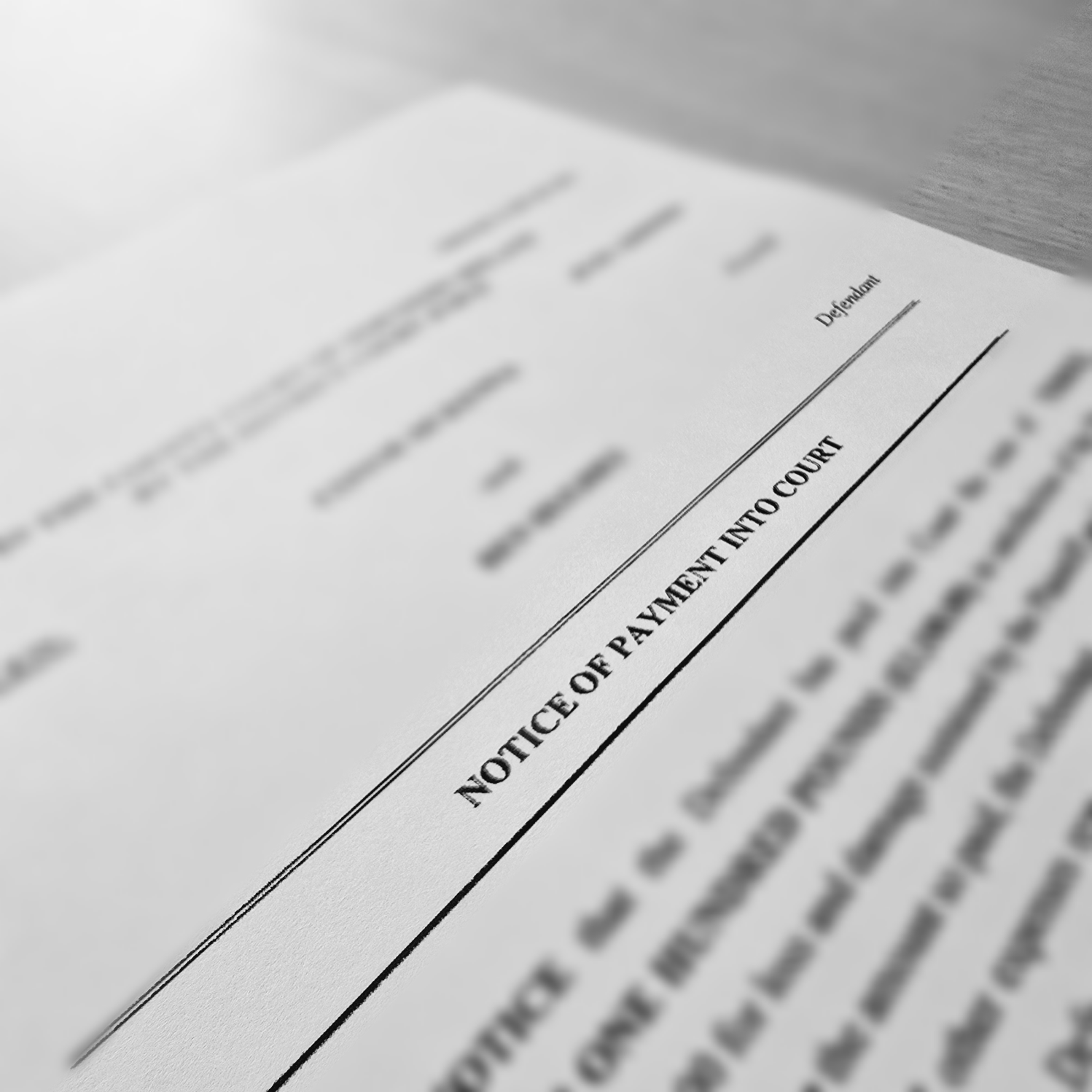‘We’ve been advised by our panel of lawyers repeatedly that lodgments don’t work and are ineffective.’ That was reported to us by a leading UK insurer during a recent meeting where our office was providing a presentation and update on litigation in NI.
It cannot be further from the truth.
Understanding the intricacies of legal procedures such as payments into court (popularly known as a ‘lodgment’) is crucial in effectively managing cases and protecting a client’s interests. Lodgments are a procedural tool often used as a means of resolving disputes without proceeding to a formal hearing, and their proper use can lead to cost savings, risk management, and streamlined settlement processes. This article will explore the key aspects of lodgments, as laid out under Order 21 of the Rules of the Supreme Court (RSC), and how they can be leveraged in insurance defence work.
What is a Lodgment?
A lodgment is a legal procedure where a defendant makes a payment into court with the intention of satisfying the plaintiff’s monetary claim. It is known as a ‘tool of compromise.’ It is not an admission of liability but offers a sum of money that the defendant believes should satisfy the Plaintiff’s claim as well as an agreement to pay the associated costs. It doesn’t create any binding legal precedent or estoppel. In essence, it is a procedural mechanism aimed at encouraging settlement and resolving disputes amicably.
It is similar in nature to the ‘Part 36’ mechanism used in England and Wales under the Civil Procedure Rules (CPR).
Key Requirements and Timing for Lodgments
The payment into court must reflect the defendant’s estimation of the sum required to resolve the claim, and it may include an element for interest up to the date of the lodgment.
In terms of timing and time limits, generally, the lodgment must be made up to 28 days after the Notice of Intention to Defend has been entered.
For personal injury actions, the lodgment must be made up to 28 days after the plaintiff serves medical evidence supporting the claim. The time limit may be extended in certain circumstances, such as when the plaintiff has not provided requested particulars or evidence.
The County Court (Amendment) Rules (Northern Ireland) 2017 makes provision for lodgements to be made after service of medical evidence other than the plaintiff’s i.e. 28 days after service of any Defence Medical evidence.
The Process of Accepting a Payment into Court
After the lodgment is made, the defendant must wait for the plaintiff’s decision. The plaintiff has 28 days to accept the lodgment. If the plaintiff accepts the lodgment, the case is considered discontinued, and the matter is settled. If the plaintiff does not accept the lodgment within the time frame, the case continues.
Impact of Accepting a Lodgment
If the plaintiff accepts the lodgment, it is treated as full satisfaction of the claim, and the case is effectively discontinued. The defendant is responsible for paying the plaintiff’s costs and expenses reasonably incurred up to the point of the lodgment, and the plaintiff can withdraw the lodged sum.
Importantly, when a lodgment is made, it does not admit liability on the defendant’s part but is purely a procedural step designed to mitigate the risk of further legal costs and a prolonged trial. As such, it serves as an important negotiation tool in resolving cases early and cost effectively, especially when the defendant believes that settlement is a preferable outcome.
What Happens if the Lodgment is Not Accepted and not ‘beaten’?
If the plaintiff chooses not to accept the lodgment, the case continues and will go to trial on all issues unless the parties settle on a higher/lower figure.
The fact and amount of the lodgment must not be communicated to the trial judge until all questions of liability and quantum are determined.
If the plaintiff wins and the final award exceeds the amount of the lodgment, the defendant will be liable for the difference along with full costs.
However, if the plaintiff fails to recover a sum greater than that lodged, there is an effect on the costs due to the Plaintiff and Defendant.
The Defendant is entitled to 25% of the scale fee for solicitor and outlay and 100% of the scale fee for counsel on the scale of the amount claimed in the civil bill.
The Plaintiff is only entitled to recover 75 % of the scale fee for his solicitor and outlay and nothing for counsel on the scale of the amount awarded.
This highlights the importance of making an accurate and reasonable lodgment, as it can limit a defendant’s financial exposure in the long run.
Case Study #1: The Impact of a Timely Lodgment at Trial
Lacey Solicitors recently defended a leading Global Insurer in a ‘damage-only’ road traffic accident claim where liability was admitted.
The plaintiff’s claim amounted to just over £23,000.00. In response, we made a timely payment into court of £15,000.00 within 28 days of proceedings being issued.
The Lodgement was refused by the Plaintiff.
Our office then took steps to robustly challenge all aspects of the claim presented to include Basic Hire Rate reports to challenge the hire claim.
The matter proceeded to full hearing and the court ultimately awarded the plaintiff £13,583.44, which was less than the lodgment amount. The court ruled that:
- £13,583.44 was to be paid to the plaintiff.
- The remaining £1,416.56 was refunded to the defendant along with any accrued interest.
There were significant cost savings to our instructing insurer.
Had the plaintiff accepted the lodgment offer, they would have received more money than the eventual court award. The timely lodgment saved our insurer significant legal costs and provided a strong reminder of the value of considering lodgments in settlement negotiations.
Case Study #2: The Impact of a Timely Lodgments during Negotiations
Orla McAteer of our office was instructed by an Irish Insurer in a material damage-only claim. The Plaintiff initially sought £4,748.86 in damages.
We made a Payment into Court in the sum of £3,100.00 in satisfaction of the Plaintiff’s claim.
The Plaintiff’s solicitors proceeded to file and serve a Certificate of Readiness, indicating that the Payment into Court was refused and their intention to continue with the case.
However, only last month, at the final stage of proceedings, the Plaintiff’s solicitors sought to accept the lodgment.
They were out of time to do so and furthermore by this stage, they had incurred additional costs and court fees as well as counsel’s fees.
Lacey Solicitors recommended consent to a late uplift but ensured that the acceptance of the Payment into Court was subject to specific conditions:
- The Plaintiff was responsible for our entire Counsel’s fee.
- Our instructing insurer would not pay any of their Counsel’s fees
- Our instructing insurer would not pay for the stamp duty fee on the Certificate of Readiness.
- Our instructing insurer would only pay 75% of their professional fee.
Had the Plaintiff’s solicitors accepted the Payment into Court earlier, they could have avoided the additional costs associated with both sets of Counsel’s fees and the costs of lodging a Certificate of Readiness. This further highlights the importance of timely consideration of settlement offers to minimise legal costs risks for the Plaintiff.
Considerations for Insurers and Insurance Defence Firms
Early Settlement: Lodgments can offer a strategic opportunity to settle cases early, saving both time and legal costs. For insurance companies, this can be an effective risk management tool, preventing unnecessary litigation.
Cost Management: By making a lodgment, the defendant can ensure that they are only liable for the costs incurred up to the date of lodgment, rather than facing increased costs if the case goes to trial.
Interest: The lodgment must include interest up to the date of the payment, which can be a factor in evaluating the amount to be lodged, particularly in long-running disputes.
Court Procedures: For insurance defence firms, familiarity with the court processes surrounding lodgments and time limits is vital. This includes understanding the potential for late acceptance, and the role of the judge in assessing costs.
Conclusion on Lodgments in NI
Lodgments and payments into court are vital tools for defendants, particularly in insurance defence cases, offering an effective way to resolve disputes without the need for lengthy court proceedings. By making a lodgment, defendants can limit their exposure to risk, reduce legal costs, and, if accepted, bring matters to a swift and final conclusion. However, it is important to carefully consider the timing, amount, and interest, as well as the potential consequences if the lodgment is not accepted. Understanding these nuances can make a significant difference in how claims are managed and ultimately resolved.
Lacey Solicitors have a respected reputation as specialist litigation solicitors and we pride ourselves on being able to assist our clients in navigating the complex court procedures, ensuring that their interests are protected at every stage of the legal process. Use our online Contact Us form to learn more.







![Finegan v. McDonald [2025] and Conflicting Expert Evidence in Personal Injury Claims in NI](https://laceysolicitors.com/wp-content/uploads/2024/04/guy-2617866-scaled-1-2048x1366-1.jpg)







